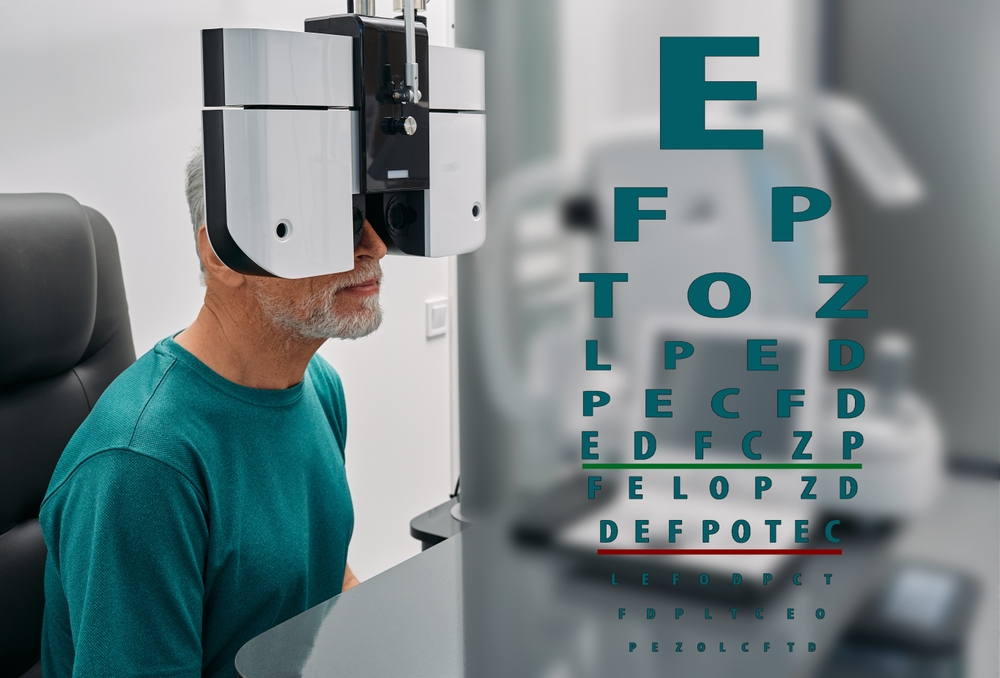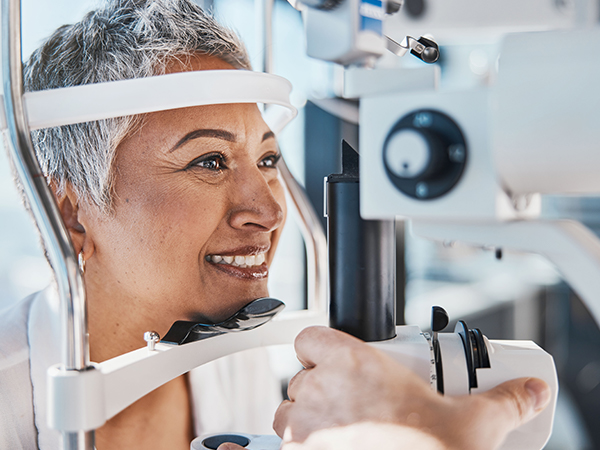Refraction Test

A refraction test, also called a vision test, is usually performed as a part of a routine eye examination. The purpose of this test is to determine if a person has a refractive error which would then mean the patient would need glasses or contact lenses.
What Is The Normal Value for Refraction Test?
A value of 20/20 is normal (optimum) vision. This means that individuals who have 20/20 vision are able to read letters that are 3/8-inch (1 centimeter) tall from 20 feet (6 meters) away. The normal uncorrected vision (without glasses or contact lenses) refractive error is zero (plano). Individuals who don’t have 20/20 vision, have what is called a refractive error. A refractive error means that the light is not bending properly when it passes through the lens of the eye. The refraction test will tell the doctor what prescription lens should be used in order to have 20/20 vision.
For people over age 40 who have normal distance vision but difficulty with near vision, a refraction test with a small type size is used to determine normal near vision and the correct power of reading glasses.
How Is The Refraction Test Performed?
The test is performed by having the patient seated in a chair that has a special device (called a phoropter or refractor) attached to it. The patient looks through the device and focuses on an eye chart 20 feet (6 meters) away. The device contains lenses of different strengths that can be moved into the patient’s view. The test is performed one eye at a time. If the patient is wearing contact lenses, they should be removed before the test.
In case the final vision is less than 20/20 even with lenses, then there is probably another non-optical problem with the eye. The vision level achieved during the refraction test is called the best-corrected visual acuity (BCVA).
What Are The Causes of Abnormal Refraction Test Results?
Abnormal results may be due to:
Astigmatism (abnormally curved cornea causing blurred vision)
Hyperopia (farsightedness)
Myopia (nearsightedness)
Presbyopia (inability to focus on near objects that develop with age)
Other conditions under which the test may be performed:
Corneal ulcers and infections
Loss of sharp vision due to macular degeneration
Retinal detachment (separation of the light-sensitive membrane (retina) in the back of the eye from its supporting layers)
Retinal vessel occlusion (blockage in a small artery that carries blood to the retina)
Retinitis pigmentosa (an inherited disorder of the retina)
There is an art to refraction and the optometrist will always answer the patient’s questions and as well as discuss their findings. Based on the results of the refraction test, they can determine the amount of myopia, hyperopia or astigmatism.

When Should Refraction Tests Be Performed?
Children should have a refraction test every 1-2 years, starting at no later than 3 years of age. Healthy adults under age 60 who aren’t experiencing vision problems should have a refraction test every 2 years, while adults currently wearing prescription glasses or contact lenses or with a refractive error should have a refraction test every 1-2 years or when their vision changes which will allow the doctor to figure out what prescription is necessary as the eyes change. In the case of encountering any vision problems between exams, the eye doctor should be seen for another refraction test.
It is important that patients with diabetes have an eye examination every year. A number of eye conditions are associated with diabetes, such as diabetic retinopathy and glaucoma. According to the American Diabetes Association, people with diabetes are at a greater risk for blindness than other Americans.
Adults over 60 or who have a family history of glaucoma, should also have a refraction test every year. Glaucoma occurs when pressure builds up in the eye, damaging the retina and the optic nerve. Regular exams will help the eye doctor screen for glaucoma and other eye conditions associated with aging and when necessary, begin early treatment.
article_category: eye surgery co-management
article_category: products
article_category: vision therapy
article_category: dogs
article_category: technology
article_category: general
article_category: eye health
article_category: aesthetics
article_category: services
article_category: faqs
article_category: exotic
article_category: large animal
article_category: contact lenses
article_category: surgical procedures
article_category: health
article_category: psychiatry
article_category: conditions
article_category: restorative
article_category: preventative
article_category: cats
article_category: eyeglasses
article_category: ocular disease management
[]
Flowbite is an open-source library of interactive components built on top of Tailwind CSS including buttons, dropdowns, modals, navbars, and more.
Check out this guide to learn how to get started and start developing websites even faster with components on top of Tailwind CSS.

All Eye Care Services
Find personalized eye care excellence with our comprehensive services. From eye exams to advanced diagnostics, trust us for all your vision needs.

Keep In Touch
For non-urgent questions or to learn more about our services, contact us today!
Old Spanish Trail Location
- Monday 9:00 AM - 7:00 PM
- Tuesday 9:00 AM - 7:00 PM
- Wednesday 9:00 AM - 7:00 PM
- Thursday 9:00 AM - 7:00 PM
- Friday 9:00 AM - 7:00 PM
- Saturday 9:00 AM - 6:00 PM
- Sunday 10:00 AM - 4:00 PM
El Con Mall Location
- Monday 9:00 AM - 7:00 PM
- Tuesday 9:00 AM - 7:00 PM
- Wednesday 9:00 AM - 7:00 PM
- Thursday 9:00 AM - 7:00 PM
- Friday 9:00 AM - 7:00 PM
- Saturday 9:00 AM - 6:00 PM
- Sunday Closed
Oracle Location
- Monday 9:00 AM - 7:00 PM
- Tuesday 9:00 AM - 7:00 PM
- Wednesday 9:00 AM - 7:00 PM
- Thursday 9:00 AM - 7:00 PM
- Friday 9:00 AM - 7:00 PM
- Saturday 9:00 AM - 6:00 PM
- Sunday 10:00 AM - 4:00 PM
Spectrum Plaza Location
- Monday 9:00 AM - 7:00 PM
- Tuesday 9:00 AM - 7:00 PM
- Wednesday 9:00 AM - 7:00 PM
- Thursday 9:00 AM - 7:00 PM
- Friday 9:00 AM - 7:00 PM
- Saturday 9:00 AM - 6:00 PM
- Sunday 10:00 AM - 4:00 PM
Save Search
Saved Searches
Modal title
One fine body…
Update Profile
This website uses cookies to enhance your experience, analyze site usage, and monitor website traffic.

